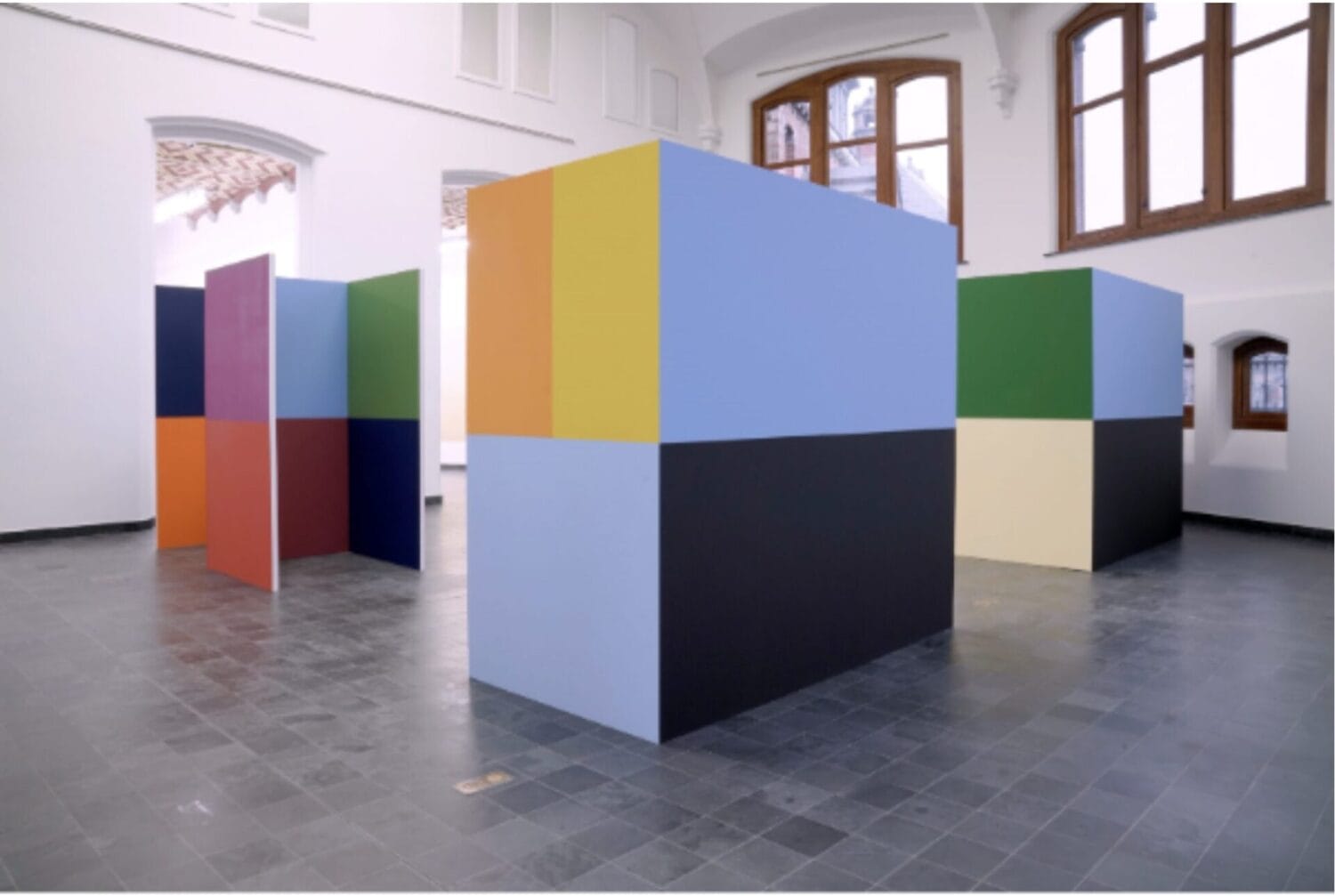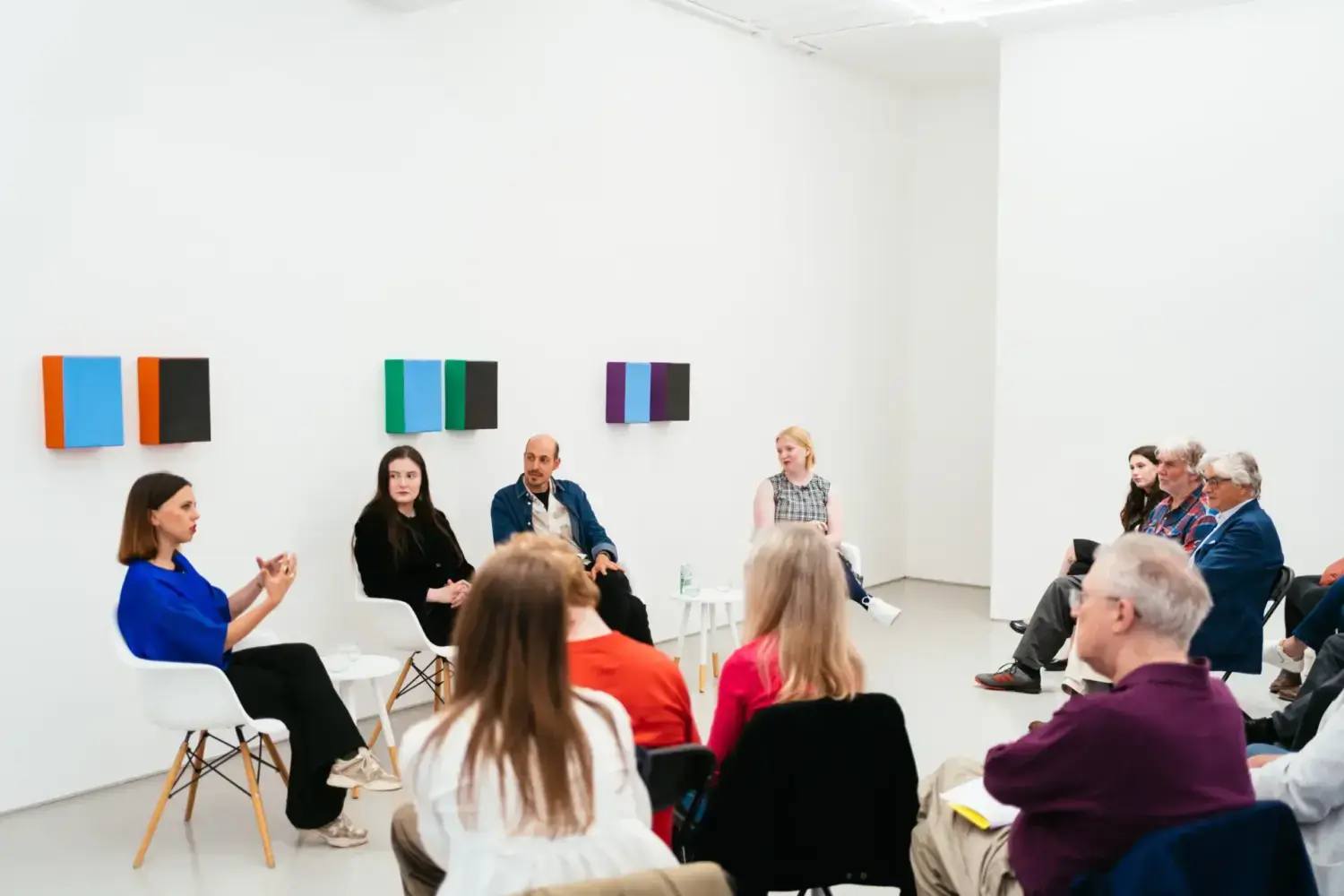Panel: Abraham Kritzman, Jo Lawson-Tancred, and Benedicte Goesaert
Moderated by Verity Babbs
Essay by Jo Lawson-Tancred
“You have a lot of freedom within a discipline, but there is a framework,” the late Belgian artist Philippe Van Snick once said. He was referring to how, in the 1980s, he applied ideas borrowed from minimalism and conceptualism to develop a highly idiosyncratic, abstract painting practice. To do so, he first invented an underlying framework for the works in which the numbers from 0-9 would correspond to the colours red, yellow, blue, orange, green, violet, black, gold and silver. This system provided an internal logic, rigour and cohesion, but crucially, it did not risk limiting Van Snick’s output. Rather, it was a framework into which he was able to introduce elements of chance with the capacity to generate infinite variation. This was the freedom to which he referred.
Indeed, the capacity of this system to sustain a prolific output over several decades is evident in the throughline between a seminal work like Dix Jours / Dix Nuits from 1985 and later examples from Van Snick’s oeuvre, like the 1988 Symmetric – Asymmetric series, which offers a fresh innovation on the same colour scheme. This relationship between a system of rules and the effects of time and other forms of unpredictable volatility mimics the same mysterious forces in nature. In this way, Van Snick found a unique language through which to translate the complexity of our world to poetic effect.
For the first time, Van Snick’s work is being shown in dialogue with that of the artist Abraham Kritzman. The exhibition title ‘+Days +Nights’ is a nod to Van Snick’s iconic series Dix Jours / Dix Nuits, reflecting his ongoing exploration of the duality of day and night—a central theme in his practice, often represented by the colours blue and black that dominate many of his compositions. This day/night principle was first introduced in 1984 and became a foundational concept in his work. The “+” symbol also relates to geometry and composition, introducing a poetic narrative that resonates with Kritzman’s work, which similarly delves into complex structures and abstract expression.
Though the similarities between Van Snick’s approach and that of Kritzman are not immediately apparent at the surface level, both artists were inspired by their encounters with real life, filtering these through their own abstracting system. In Van Snick’s case, the artist was particularly fond of the overgrown garden at his home in northern France, where he created some works and made a few site-specific art installations. Meanwhile, Kritzman’s new series Sides of Love (2025) – double-sided, suspended aluminium sculptures on which are loosely sketched fragments of figuration – was inspired by a 2023 residency in Greece. There, the artist discovered a crumbling scene of two people kissing inside an old church, which he later blew up and fractured on Photoshop, cropping sections arbitrarily and embedding them within these beguiling, gestural works. Though the final effect is a far cry from Van Snick’s coherent, clean-lined style, the treatment of the source material echoes the way in which those building blocks of colour could either be stacked or be scattered across an expanse. While “this randomness creates something new,” as Kritzman recently explained, the original composition is not lost. It could be recovered by correctly reassembling each of the 10 pieces into a rectangle. Further, the works contain their own Van Snick-esque duality, with the front’s densely layered crust finding its mirror opposite in the concave pattern on the reverse.
As both artists’ practices demonstrate, the adherence to an underlying system rather than strict fidelity to any one medium provides plenty of opportunity for transferring their ideas into new contexts. Whether working in painting, sculpture or a hybrid form, neither has shied from the use of simple materials, most particularly Van Snick, whose recycling of commercial packaging as a canvas for many early paintings set them in playful opposition to the high culture aspirations of most minimal art.
The opportunity to be staged in dialogue with the elder Belgian artist prompted Kritzman to study past installations of Van Snick’s work and have this inform his own approach. In particular, both artists seek to reject narrative in favour of encouraging a more open-ended, experiential mode of viewing. “There’s always this really interesting tension in Van Snick’s work when you’re there in the space with it,” he recently commented. “I think what’s fascinating is that it has this mathematical, abstract, random process, but then it has such power in the space itself, not just conceptually.” Indeed, Van Snick himself said, “a framework is something you can find yourself in,” meaning that “the physical experience is of major importance.”
Van Snick often made large-scale interventions in the gallery that required his audiences to navigate the space in particular ways. Towards the end of his life, he prepared the site-specific installation Territorium as a proposal for the Belgian Pavilion at the 2017 Venice Biennale. Although the proposal was not realised, an exhibition of Territorium was later presented at KIOSK in Ghent. According to these plans, several distinct series would occupy their own planes, with a balanced mix of wall and floor-based works. The central space was divided up by Dorp, an artwork consisting of six architectural constructions made from painted wooden boards. “Van Snick invites the visitor to walk through a spatial landscape and, in so doing, to surrender to the experience and to wander through this labyrinthine structure,” according to Wim Waelput, the curator of the project. “Each visitor views the structure from their own perspective and consequently experiences the work in their own way.”
The layered aims of space and perspective, resonate within the unique layout of ‘+ Days + Nights’. Allowing a closer look at Kritzman’s works to proposes new answers to the same question of how the viewer can be pulled into a physical interaction with art.
Changes in our position and orientation transform our understanding of the double-sided Sides of Love series. Meanwhile, our awareness and experience of the entire gallery space is determined by our position in relation to Through the Night with C and C (2025). In creating this monumental structure within which to install his works, Kritzman is developing an idea he initiated in his 2022 – 2023 show “Land’s End” at the gallery’s Deptford location. The tall wooden frame contains panels that act as dividers, cutting through the gallery and preventing us from taking in the whole show at one time. In order to admire the small ceramics that adorn the structure, we must move up close, barricading ourselves away from the other works and entering into an intimate communion with these delicate pieces. Much like any other rigid system in Kritzman and Van Snick’s work, the installation is activated by the unpredictable, fluid, and chance nature in which each individual viewer decides to move and encounter the art.

Exhibition view of Territorium by Philippe Van Snick, KIOSK, Ghent, 2020. Photograph: Thomas Ost. Courtesy of the Artist’s Estate and KIOSK, Ghent.

